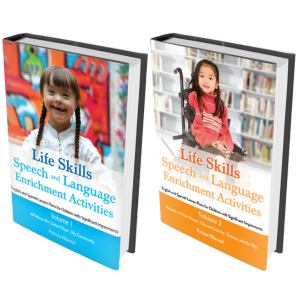Children with Down Syndrome are truly unique in the way they communicate and interact. Speech therapy can often be difficult because Down Syndrome characteristics involve so many different developmental domains. For example, there are anatomical and physical differences, such as low muscle tone as well as a high, narrow palette relative to tongue size. But, at the same time a child can have a highly functional vocabulary of gestures and strong receptive language skills.
As a whole, specific Down Syndrome characteristics impact communication in six unique domains::
- Anatomical and physical differences
- Hearing development
- Cognitive development
- Social/emotional skills
- Motor skills
- Language development
The good news is that by knowing about the unique development in these six areas, we can account for specific limitations and still have really robust communication. The trick is to lean heavily in the direction of a child’s strengths. Across the following six areas you are going to see that there are MANY!

Anatomical and Physiological Differences
Let’s start off with the visible characteristics. Children with Down Syndrome inherently present with certain anatomical and physiological differences. Low muscle tone in the tongue and cheeks results in less firm and less precise production of speech sounds. When you add low muscle tone to decreased coordination, it is easy to see why these children often exhibit reduced intelligibility.
Other Down Syndrome characteristics that are often present include a high narrow arched palette, large tonsils and adenoids, and a small mouth and jaw area in comparison with the size of the tongue. These physical characteristics combined with low muscle tone contribute to the difficulty children with Down Syndrome have in producing certain sounds and certain sound combinations required for intelligible speech.
I wanted to add one more comment here as it relates to concerns we often hear from parents. A common parent concern is tongue protrusion. These anatomical differences help to explain part of that. But additionally, we know that the tongue is a muscle and it needs to be contracted. With the low muscle tone, the tongue will naturally not contract. Add to this the fact that another Down Syndrome characteristic is smaller airways and it makes sense that an open mouth is the natural resting position for breathing. It’s just more comfortable.
Anatomical and physiological differences include: low muscle tone, low muscle coordination, high narrow arched palate, large tonsils and adenoids, and small mouth and jaw area in comparison with the size of the tongue.
Down Syndrome Characteristics for Hearing Development
In terms of hearing development, children with Down Syndrome often have otitis media with effusion, and that’s not necessarily an infection. It’s just a buildup of fluid behind the eardrum as a result of the anatomical differences, such as the narrower and shorter ear canal. As a result of otitis media with effusion children with Down Syndrome often present with fluctuating conductive hearing loss during the first few years of life.

We all know how vital this period of life is for communication development. It’s really important for us as speech pathologists to make sure that parents and the schools are keeping up with hearing screenings because this can definitely affect our intervention. More than 80% of preschool children with Down Syndrome require tympanostomy (tube placement) in the eardrum to manage otitis media.
And for those requiring medical treatment, 81% had abnormal hearing prior to treatment. So encountering children within this population who have trouble hearing is a pretty common occurrence, and we need to stay on top of that.
Down Syndrome Characteristics with Cognitive Development
Under the cognitive domain children with Down Syndrome show relative strengths in visual-spatial processing and visual motor skills. Visual tasks include block building, drawing lines, copying and folding, and visual-motor skills involved in use of gestures and early communication. These can be considered to be a relative strength in these children.

Verbal processing is a relative area of difficulty due to specific neurological abnormalities. Short-term and long-term memory can be severely low, as well as the ability to engage in tasks and sustain attention. Research suggests that these behaviors are not necessarily due to a lack of motivation or task difficulty. For example, when a child with Down Syndrome is not engaging in an activity, it may not mean that the task is too difficult, but rather that they are unable to sustain attention due to a neurological deficit.
I want to share an example of this. I have a life skills classroom and I typically start out our session in a group circle time, which can last about 30 minutes. This is a long time for a student to sustain attention. With one of my students with Down Syndrome, I’ve found that it helps for him to hold some sort of manipulative or to have a book in his hand that also relates to the academic content in which we’re covering. This helps him to stay engaged and sustain attention throughout circle time. And also the teachers have found that this is a strategy that can be used throughout the day.
Cognitive Strengths = Visual-Spatial Processing and Visual-Motor Skills.
Social/Emotional Characteristics
Under the Down Syndrome characteristics related to the social/emotional domain, these children generally have a strong desire to interact with others. They have also been noted to use facial expressions effectively to help them communicate. Studies find that children with Down Syndrome display more socially interactive behaviors such as smiling and initiating turn-taking routines when compared to their typically developing peers.
However, these children present with challenges in this domain as well. Delayed reciprocal eye contact in the early stages of development has been noted in children with Down Syndrome. Overall, their ability to establish and maintain eye contact develops at a slower rate in comparison to typically developing peers. Once the skill has been learned, children with Down Syndrome tend to maintain high levels of eye contact. In turn, they show less interest in exploring their surrounding environment resulting in missed opportunities to label and request objects. So when working with children with Down Syndrome, it’s important to note the triad of joint attention between the person speaking, the person listening, and the objects around them. We definitely don’t want them to miss out on the world around them.
Social/Emotional Strengths = Desire for Social Interaction, Use of Facial Expressions, Reciprocal Eye Contact, Interest in Exploring Environment When Asked.
Motor Skills Domain
Moving on to the motor skills domain, relative strengths have been observed in the early use of gestures. Gestures mark an important step in non-verbal communication development. The development of gestures, such as pointing, typically begins around 12 months and allows the young children to direct the attention of people around them.
In other research (Study 1, Study 2) they found that when matched for language and age, children with Down Syndrome produced significantly more referential pointing gestures than typically developing children. This occurred during the pre linguistic period and during the early period of lexical acquisition. And again, for Down Syndrome language therapy purposes, it helps us to know this because we also want to take advantage of their use of gestures in order to increase joint attention.
The motor movements needed for daily living and personal independence are eventually achieved by children with Down Syndrome. However, their movements may seem less precise as they carry out tasks. The Down Syndrome characteristic of low muscle tone likely has an impact on delayed motor development too. It results in difficulties with balance, posture, strength, flexibility, and planning. So as speech pathologists, we definitely see how difficulty with motor planning affects speech. Therefore, it is important to have an alternate method of communication in order to develop these skills.
Down Syndrome Language Development
We saved the biggest and best for last. Down Syndrome language characteristics have the biggest impact on our job as speech-language pathologists. The prior 5 are important and hopefully you see how they can influence communication. Now let’s talk about language communication itself. We have two super cool graphs that bring together different research on this population.
As age increases, children with Down Syndrome appear to make greater gains in receptive language skills compared to the emergence of expressive language. Not only do comprehension skills surpass production skills, but also the gap widens with increasing chronological age. Here we have a Down Syndrome language development chart that illustrates this really nicely. On the X axis, you’ll see the language milestone and on the Y axis, you’ll see the age. Down Syndrome language development begins as expected until the age of approximately nine months.
Studies have shown that these children do not differ in the number of early phonemes produced or the time spent vocalizing sounds. Children with Down Syndrome show slight delays during the stages of joint attention and canonical babbling. However, the delay in the development of first words is much more significant. And usually this is the time when parents really notice because they’re expecting their children to start saying their first words but they don’t.
Down Syndrome Language Development Charts

For those of us working in the ECI population, we can start intervening early. For those of us working in the schools, we can see that the gap between those with Down Syndrome and peers with typical development is much larger when we start working with these children than when they are in early childhood programs. What we can do for these children is utilize their strengths, like receptive language, to build on their areas of need.
Children with Down Syndrome struggle with expressive language, specifically in the areas of vocabulary, grammar, and syntax. We have another graph that’s going to outline vocabulary development. This chart compares the vocabulary development of children with Down Syndrome to typically developing peers. On the X axis, we have the age in months going across. And then on the Y axis, we have the number of words that are typically spoken.
The blue line represents typically developing peers, the orange line is a study done by Kumin, Councill, and Goodman. It’s a little higher than the red line, which is a study done by Buckley. This is because Kumin et. al. were counting not only spoken words, but the number of times words were used as well. And what we see here is verbal production of first words is delayed by approximately 12 months.

The gap between the verbal production of children with Down Syndrome and typically developing peers continues to widen over time. At 72 months, children with Down Syndrome can be expected to have approximately 300 to 400 words while typically developing peers have several thousand words in their vocabulary. Also, the development of morphological structures follows the same pattern of acquisition when compared to typically developing peers.
These children also struggle with formulating appropriate syntactic forms, often omitting obligatory functional words, such as articles and prepositions due to limited vocabulary, and difficulties with grammar. These children produce what could be described as shorter telegraphic-like utterances.
Down Syndrome Language Therapy
We want you to be able to take this information and apply it to the children you are working with. The long-story-short is that there are definitely delays in development or at least differences across all areas. Down Syndrome is common enough that we know what these differences are and can account for them in the work we are doing with these children. It makes for greater progress and less frustration when we know what to expect and where we can make gains.
If you are interested in upping your Down Syndrome language therapy game, we wrote a course about it where we introduce Total Communication and show how it is a great way to account for all the differences we noted above and still make progress. Watch this short video to find out more and then click here.



